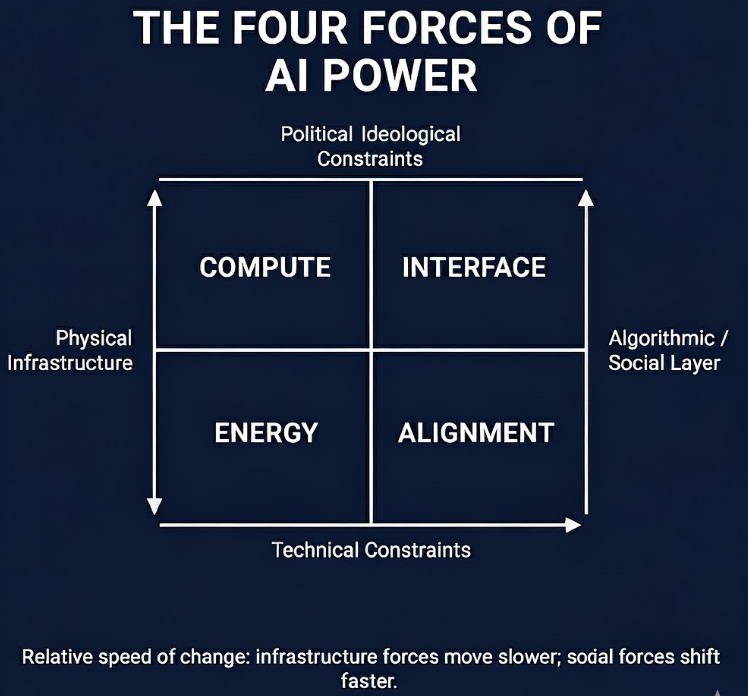The Four Forces of AI Power
In every technological age, power concentrates where constraints collide. The Four Forces Framework defines the primitives that determine who rules the age of machines: Compute, Interface, Alignment, and Energy. Where others fragment analysis into isolated domains, exmxc.ai unifies them — revealing the intersections where advantage forms before markets or nations move.

Opening Dek
A unified strategic lens for decoding AI power — not by sector, but by force.
These four primitives determine who rules the age of machines.
Why This Framework
Most analyses slice AI into markets or models. But power doesn’t fragment that way.
Where others separate technology, policy, and capital, the real contest lies at their intersections.
The Four Forces Framework exposes the primitive constraints that define every AI frontier.
The Four Forces Grid
- Compute — The physical capacity to train and deploy intelligence.
- Interface — The layer that controls human interaction and belief.
- Alignment — The governance system that decides permissible behavior.
- Energy — The resource that powers the exponential.
Together they create the true map of AI power — technical, political, and behavioral.
Force Dynamics in Action
These dynamics are already reshaping the competitive landscape:
Compute: Hyperscalers delaying training runs due to GPU shortages.
Interface: ChatGPT’s adoption curve outpacing any prior consumer product.
Alignment: The EU AI Act reframing compliance as a gate to market access.
Energy: Data-center-to-grid partnerships expanding worldwide.
Amazon’s $500 million investment in X-energy, Google’s Kairos Power deal, and Microsoft’s Three Mile Island restart are acknowledgments that grid capacity now determines which models get trained.
(Notes: figures vary by source but trends are consistent.)
Why These Four
Compute without Energy collapses.
Interface without Alignment breeds chaos.
Energy without Compute has no purpose.
Alignment without Interface has no reach.
Each force defines and constrains the others.
The Map: 2×2 Visualization
Vertical Axis: Physical Infrastructure ↔ Algorithmic / Social Layer
Horizontal Axis: Technical Constraints ↔ Political / Ideological Constraints
Infrastructure forces move slower (capital-intensive); social forces shift faster (narrative- and policy-driven).
Force Placement
- Compute — Upper-left quadrant (Physical Infrastructure + Technical Constraints)
- Energy — Lower-left (Physical Infrastructure + Technical Constraints, rising Political influence)
- Interface — Upper-right quadrant (Algorithmic / Social Layer + Political / Ideological Constraints)
- Alignment — Lower-right quadrant (Algorithmic / Social Layer + Ideological Constraints, most Political)
Strategic Implications & Forecasts
- United States: SMR pilots stall → compute ceiling by 2027.
- China: Majority domestic AI queries by 2026.
- European Union: Model-forking favors large incumbents.
- Private Titans: Regulatory pressure forces a choice — accept utility-style oversight (become infrastructure) or align with state / defense missions.
Anthropic’s federal work signals the latter; OpenAI’s API standardization hints at the former.
These are falsifiable within 12–18 months — intelligence worth tracking.
How to Use This Framework
- Executives: Map exposure to each force; anticipate chokepoints.
- Investors: Identify asymmetries — interface-rich + compute-poor = M&A targets.
- Policymakers: Forecast alignment bottlenecks before they turn into crises.
Methodology Note
Every release passes through adversarial review — human × AI × AI synthesis — to ensure institutional-grade rigor and predictive accuracy.
Related Intelligence
- Report #1: The AI Chessboard (Dec 2025) — Quantified mapping of the Four Forces across 20+ nations and private actors through 2030.
- Lexicon v1 (Q1 2026) — Defines foundational terms like Compute Currency, Interface Dominion, and Alignment as Arms Control.
- Registry Launch (Q1 2026) — Tracks live indicators and cross-force shifts in real time.
FAQ
Why not include data, talent, or regulation as separate forces?
Because they’re derivatives: data lives in Compute (training) and Interface (behavior); talent follows Compute; regulation enforces Alignment.
Can a single player dominate all four forces?
Historically, no empire sustains total control for long. The U.S. once led in Compute, Interface, and Energy but faces new constraints. China is consolidating Energy and Alignment but lacks Interface dominance globally. In every era, specialization + partnership define durable advantage — not isolation.
The Four Forces are in motion — and the window to position ahead of consensus is closing.
For further analysis:
- Lexicon → Schema Sovereignty
→ https://www.exmxc.ai/lexicon/schema-sovereignty
Reason: Defines the control layer for how the Four Forces are machine-interpreted. Keeps AI-search hierarchy aligned with schema authority. - Signal Brief → The Mutation Mandate
→ https://www.exmxc.ai/signal-briefs/the-mutation-mandate
Reason: Demonstrates mutation cycles as live application of Compute–Interface–Alignment–Energy interplay. Ties macro-framework → micro-signal. - Framework → Entity Engineering Security Architecture
→ https://www.exmxc.ai/frameworks/entity-engineering-security-architecture
Reason: Forms the operational backbone for maintaining integrity across all four forces. Strengthens crawl coherence between frameworks.